Latest Composite Price Indices Drop Driven by Economic Downturn, Investor Uncertainty in Second Quarter
CCRSI RELEASE – July 2020
(With data through June 2020)
Print Release (PDF)
Complete CCRSI data set accompanying this release
This month's CoStar Commercial Repeat Sale Indices (CCRSI) provides the market's first look at commercial real estate pricing trends through June 2020. Based on 669 sale pairs in June 2020 and more than 228,245 repeat sales since 1996, the CCRSI offers the broadest measure of commercial real estate repeat sales activity.

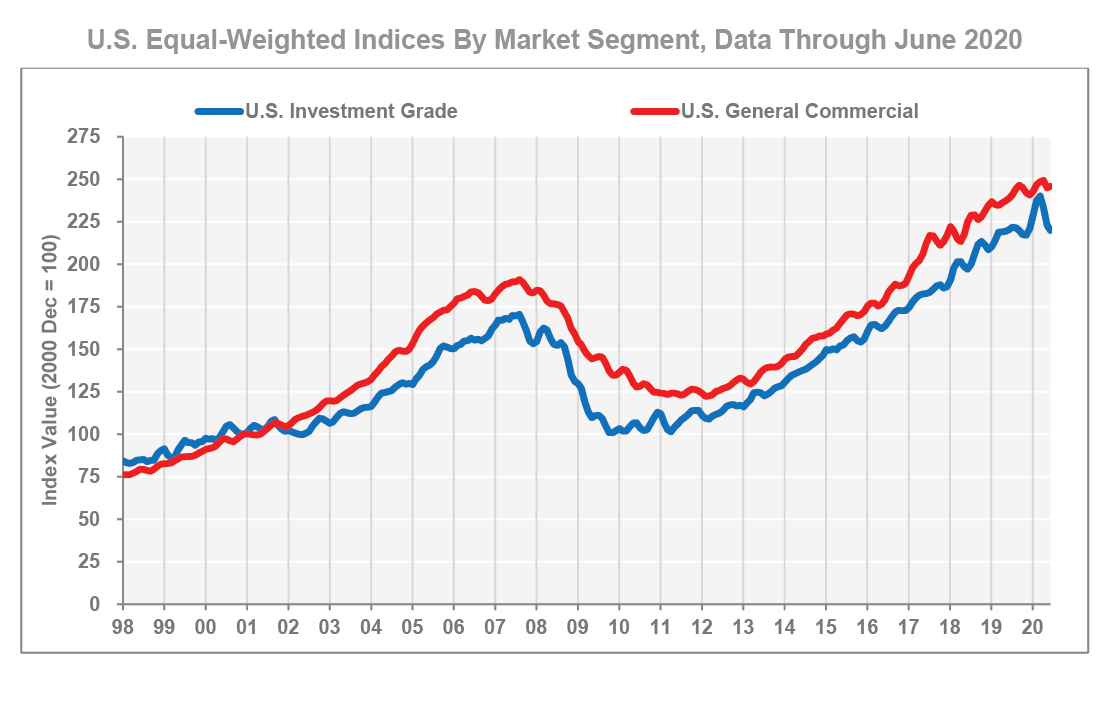
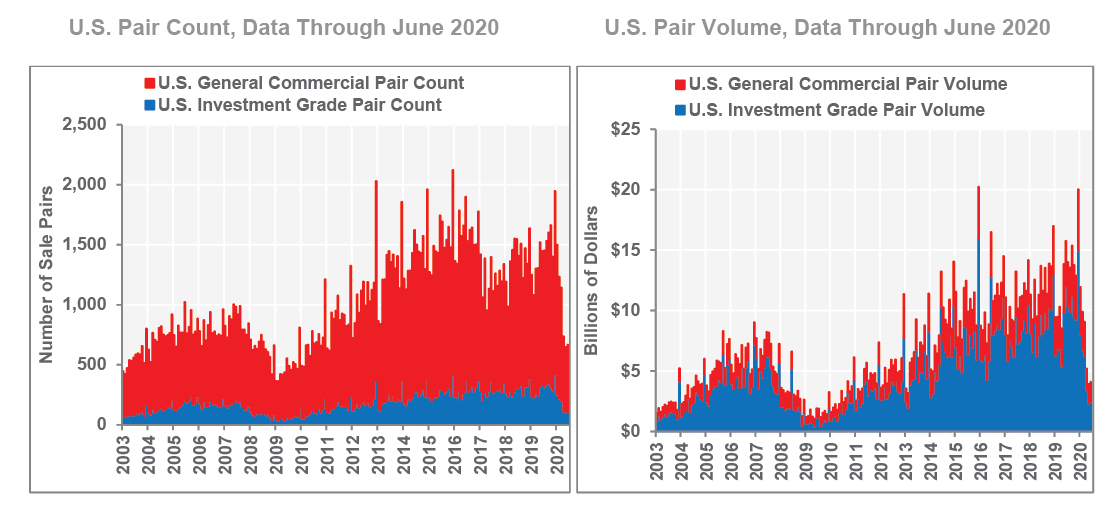
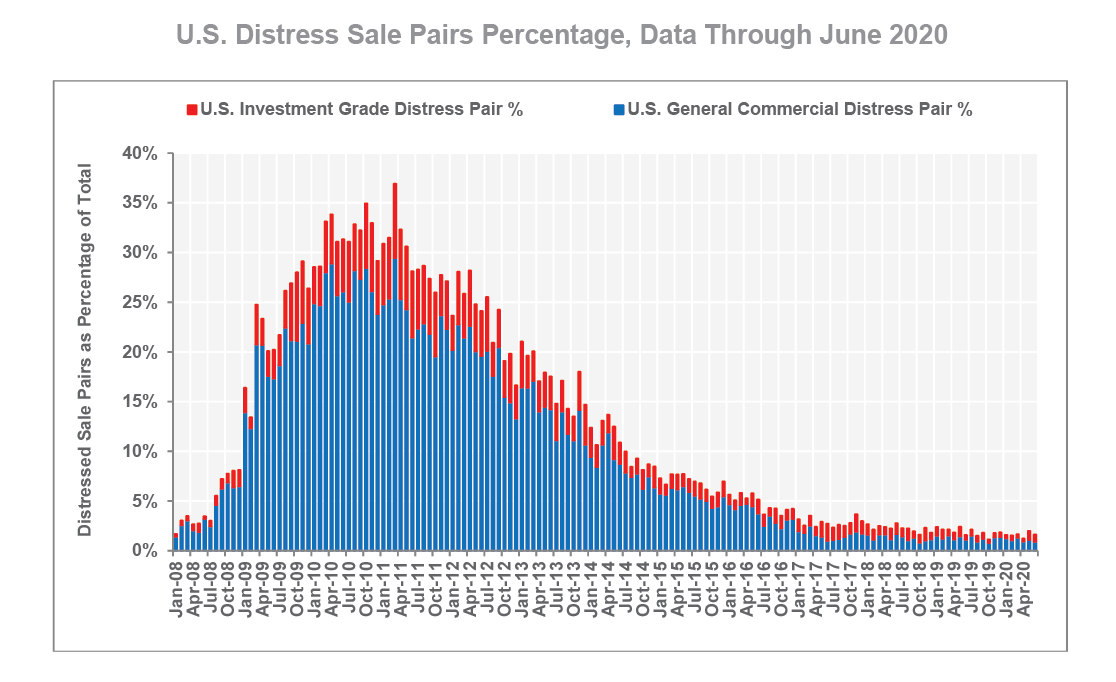
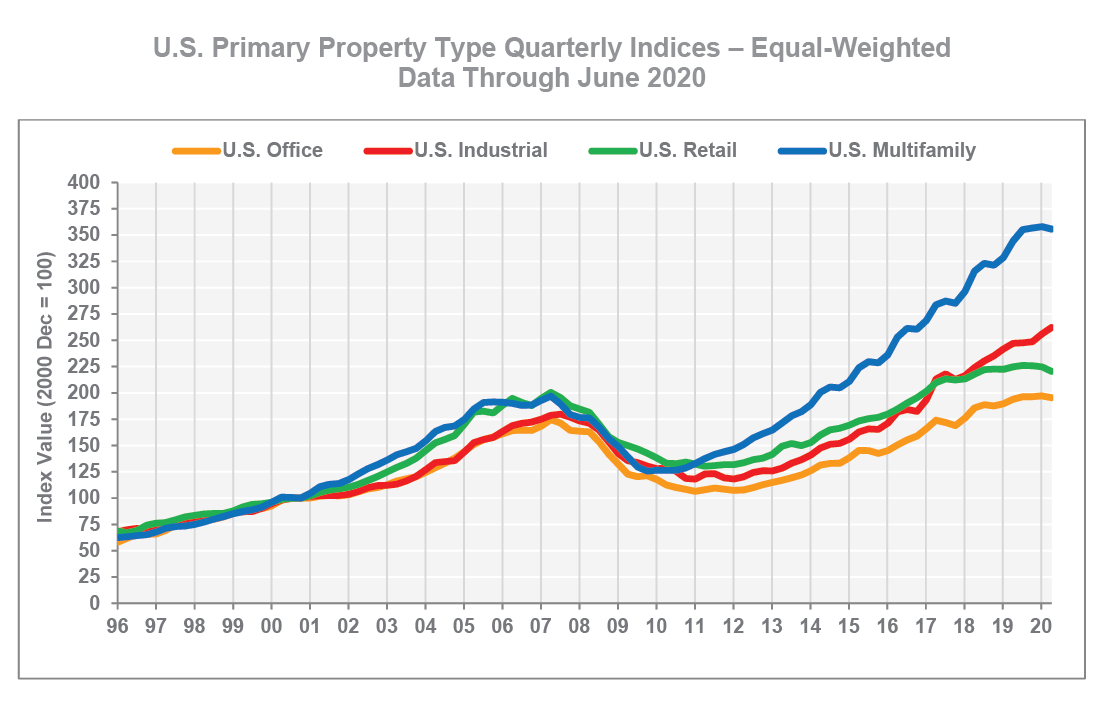

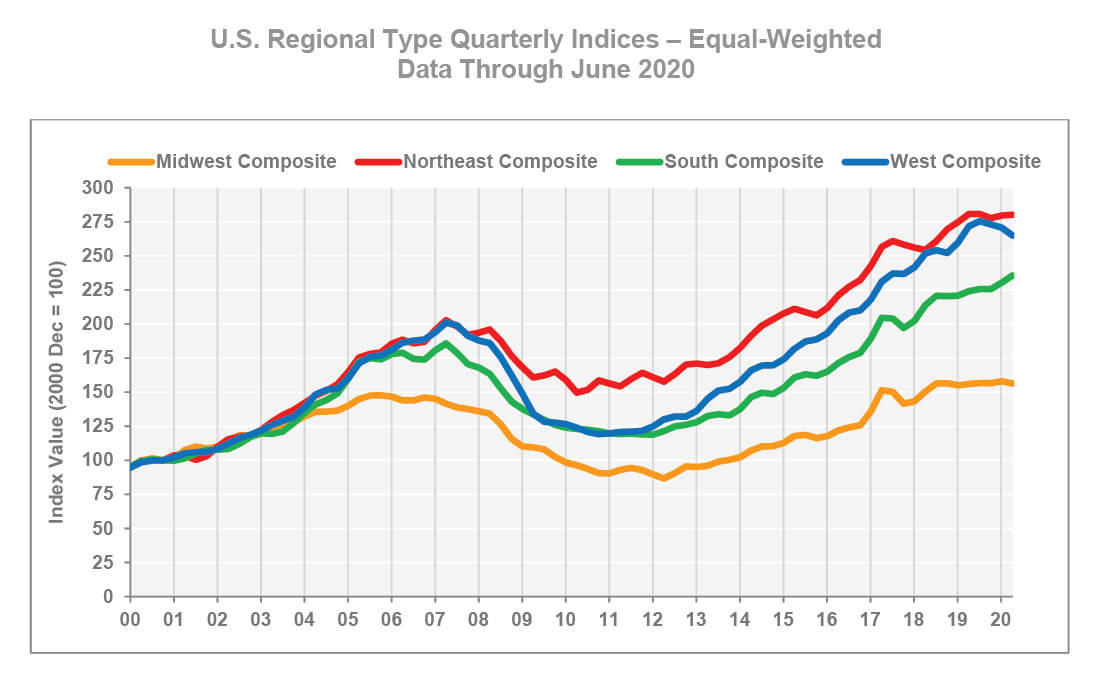
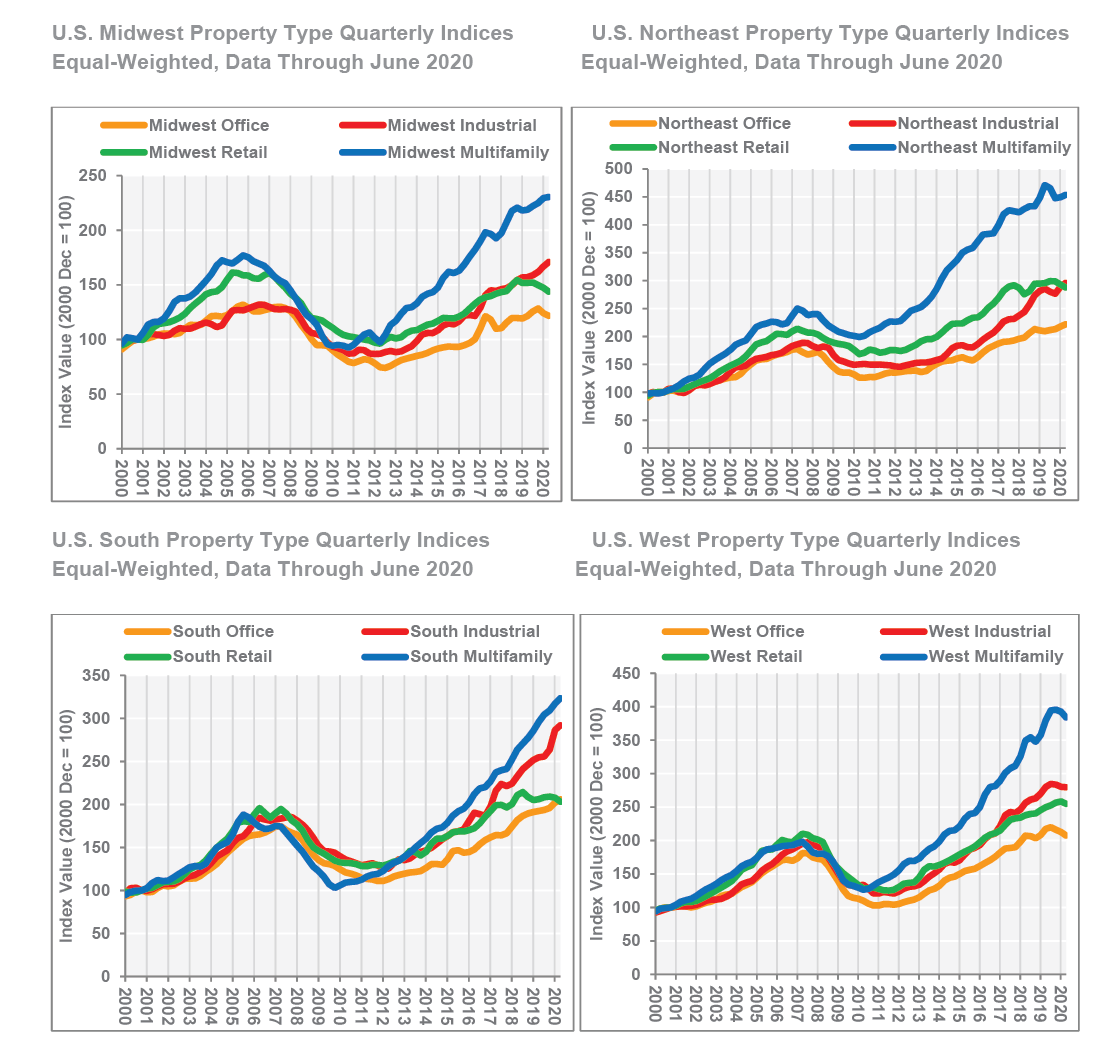
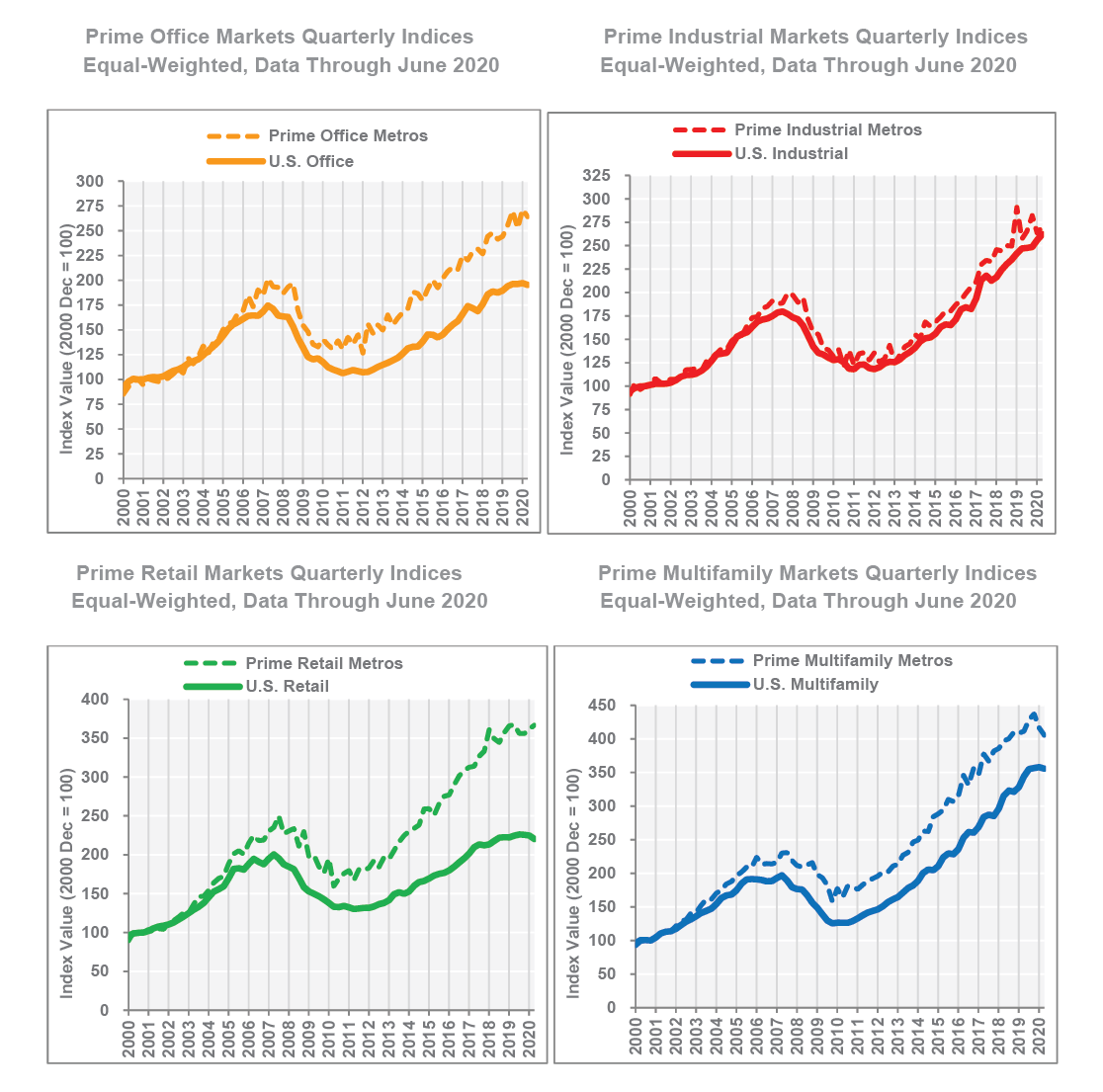
CCRSI National Results Highlights
-
COMPOSITE PRICE INDICES DECLINED IN THE SECOND QUARTER AMID THE ECONOMIC DOWNTURN AND INVESTOR UNCERTAINTY TRIGGERED BY THE CORONAVIRUS PANDEMIC. The value-weighted U.S. Composite Index, which reflects the larger asset sales common in the core markets that led the previous recovery, declined 1.7% in the second quarter of 2020, contributing to a loss of 0.6% in the 12-month period ending in June 2020. Meanwhile, the equal-weighted U.S. Composite Index, which reflects the more numerous but lower-priced property sales typical of secondary and tertiary markets, dipped 2.7% in the second quarter of 2020 but was still up a modest 2% for the 12-month period ending in June 2020.
-
THE TWO SUB-INDICES OF THE EQUAL-WEIGHTED INDEX GENERALLY MIRRORED COMPOSITE INDEX TRENDS. The Investment-Grade segment of the index, which is influenced by higher-value properties, dipped 8.4% in the second quarter of 2020, contributing to a loss of 0.2% in the 12-month period ending in June 2020. Meanwhile the General Commercial segment, which is influenced by smaller, lower-priced properties, also fell in the second quarter of 2020 by 1.1% but still showed price growth of 3% in the 12-month period ending in June 2020. The trends within the equal-weighted composite index suggest that smaller deals by investors with less capital to allocate were more likely to transact during the last couple of quarters.
-
YEAR-TO-DATE TRANSACTION VOLUME REMAINED DEPRESSED. Reflecting the uncertainty prevailing in the market around rising coronavirus infection rates and the resulting impact on economic growth, sales volume totals were well off the pace of previous years. Composite pair volume of $44.2 billion in the period from January to June 2020 marked a 35% decrease from the average volume that was logged in the January to June period in both 2018 and 2019. Sales activity declined 38% for larger properties in the Investment Grade segment, while General Commercial segment volume, dominated by smaller properties, decreased 26% from January to June 2020 compared to the same period in 2018 and 2019.
-
PRICING IN THE INDUSTRIAL SECTOR HELD UP THE BEST DURING THE SECOND QUARTER, WHILE THE RETAIL SECTOR LAGGED. The accelerated adoption of e-commerce during the pandemic helped fuel the stronger performance of industrial pricing. The U.S. Industrial index rose 2.4% in the second quarter of 2020, the only property type index to experience a gain during this time. Lockdowns and social distancing exacerbated what already was a challenging environment for physical retail, and retail experienced the sharpest quarterly decline of 1.9% among all four major property type indices in the second quarter of 2020.
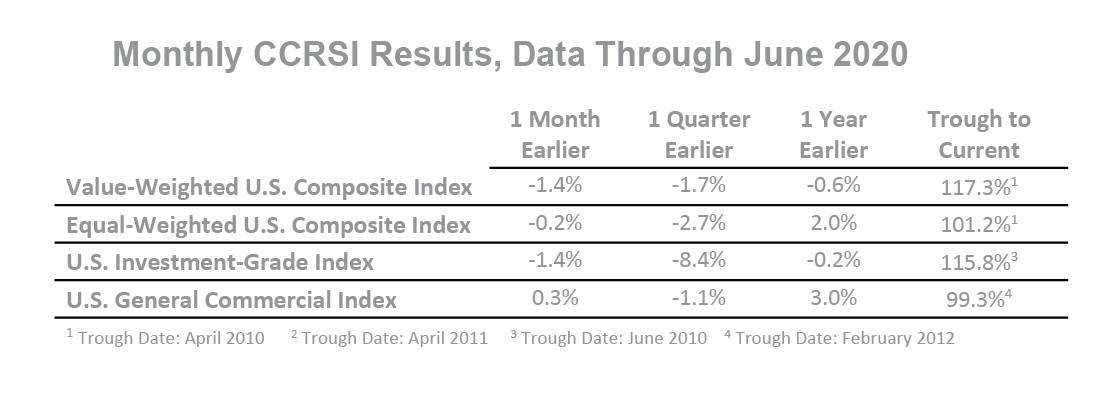
Quarterly CCRSI Property Type Results
-
PERFORMANCE VARIED AMONG PROPERTY TYPES DURING THE SECOND QUARTER. The Industrial index was the only property type to maintain positive momentum through the second quarter of 2020, while the other property type indices, including Land and Hospitality, all fell by varying degrees. Smaller properties located outside of the core coastal markets avoided the worst of the price declines in the second quarter of 2020, specifically in the Multifamily and Office sectors. The Prime Metros indices in the Multifamily and Office sectors, which are dominated by the large core coastal metros, experienced declines of 2-3% in the second quarter of 2020.
-
THE INDUSTRIAL INDEX LED GROWTH AMONG THE FOUR MAJOR PROPERTY TYPES. Backed by the tailwinds of rising e-commerce adoption that fueled demand for industrial real estate, industrial pricing has weathered the current, uncertain economic environment better than any other property type. The U.S. Industrial index increased 2.4% in the second quarter of 2020, contributing to an annual gain of 6% in the 12-month period ending in June 2020. Pricing remained resilient in larger properties in core markets as the Prime Industrial Metros Index advanced at a similar rate of 5.2% in the 12-month period ending in June 2020.
-
THE TOP END OF THE MARKET SHOWED THE MOST WEAKNESS IN THE MULTIFAMILY INDEX. The U.S. Multifamily Index ticked down 0.6% in the second quarter of 2020, although prices were still up by 3.3% in the 12-month period ending in June 2020. Pricing weakness was felt most acutely at the top of the market in the Prime Multifamily Metros Index. While pricing in the Prime Multifamily Index surged over the course of the last cycle, with the index swelling nearly 90% higher in 2019 than at the peak of the previous cycle, the pressures of an economic slowdown and a wave of new construction deliveries has weighed on the index in the last couple of quarters. The Prime Multifamily Index fell 2.6% in the second quarter of 2020 after a 4.7% drop in the first quarter, contributing to a decline of 1.4% in the 12-month period ending in June 2020.
-
OFFICE PRICES REGRESSED A MODEST 0.9% IN THE SECOND QUARTER. Amid a challenging underwriting environment, the U.S. Office Index fell 0.9% in the second quarter of 2020, contributing to an annual decline of 0.7% in the 12-month period ending in June 2020. Price growth in the Prime Office Metros Index fell a steeper 2.7% in the second quarter of 2020, as the broader market generally held up better relative to the core coastal markets.
-
PRICING IN THE RETAIL INDEX FELL MORE IN THE SECOND QUARTER THAN IN ANY OF THE FOUR MAIN PROPERTY TYPES. The U.S. Retail index fell 1.9% in the second quarter of 2020, contributing to a similar loss of nearly 2% in the 12-month period ending in June 2020, as the pandemic-induced lockdowns and social distancing requirements curtailed consumer spending at physical retail locations. Necessity-focused retail, including grocery-anchored centers, continued to command stronger investor interest, while malls and other centers with a high exposure to competition from e-commerce experienced the most significant regression in pricing. The Prime Retail Metros Index held up better than the overall market, posting growth of 1.4% in the second quarter of 2020 but was still down 0.3% in the 12-month period ending in June 2020.
-
U.S. HOSPITALITY INDEX WEAKENED AMID TRAVEL RESTRICTIONS AND LOCKDOWNS. Hospitality fundamentals have been hit hard by the pandemic as travel restrictions and lockdowns curtailed demand and depressed occupancies and RevPAR (revenue per available room). The U.S. Hospitality Index dropped 3.9% in the second quarter of 2020, although pricing was still up 3.5% in the 12-month period ending in June 2020.
-
U.S. LAND INDEX REMAINED VOLATILE. The U.S. Land Index is currently the most volatile of the property type indices. After falling throughout most of 2018 and early 2019, the index rebounded over the last few quarters, but was still susceptible to the more cautious investment environment. The U.S. Land Index fell 0.3% in the second quarter of 2020, although it was still up 10% in the 12-month period ending in June 2020.
Quarterly CCRSI Regional Results
-
THE SUNBELT MARKETS IN THE SOUTH REGION MAINTAINED STEADIER GROWTH IN THE SECOND QUARTER THAN IN OTHER REGIONS. The South regional index remained on an upward trajectory in the second quarter of 2020, expanding 2.4%, with three out of the four regional property type indices in positive territory. Following the national trend, the South Retail Index exhibited some weakness in the second quarter of 2020, falling 2.2%. A higher concentration of faster growing, low cost metros in the South region has bolstered both demand for commercial real estate and pricing in the South region.
-
INDUSTRIAL SEGMENT LED GROWTH IN NORTHEAST. The Northeast Composite Index ticked up a modest 0.2% in the second quarter of 2020, but overall the index has remained relatively flat over the last four quarters, as pricing had already surged 38% above prior peak levels reached in the last recession. Rising 2.4% in the second quarter of 2020, the Northeast Industrial Index was the strongest performing property type index in the region and offset a loss of 1.8% in the Northeast Retail Index.
-
RETAIL SUFFERED THE LARGEST DECLINE IN THE MIDWEST REGIONAL INDEX. The Midwest Composite index edged down 1% in the second quarter of 2020, placing the index at roughly the same level it was at 12 months ago, in June 2019. The Midwest Retail index has been the largest drag on recent performance, falling in three out of the last four quarters ending in June 2020. Meanwhile, the Midwest Industrial Index advanced 2.4% in the second quarter of 2020, the second strongest growth rate among the 16 regional property type indices and was up a solid 8.8% in the 12-month period ending in June 2020.
-
WEST INDEX WAS CHALLENGED BY BROAD-BASED PRICE WEAKNESS ACROSS THE PROPERTY TYPES IN THE SECOND QUARTER. Although the West Composite Index had some of the strongest growth momentum over the latter years of the last cycle in 2018-19, price gains have begun to stall in 2020 in those same markets that saw significant runups in pricing last cycle. The West Composite Index fell 2.1% in the second quarter of 2020 and 2.5% in the 12-month period ending in June 2020. The West Industrial segment has held up the best in the second quarter of 2020, with losses limited to just 0.2%.
About The CoStar Commercial Repeat-Sale Indices
The CoStar Commercial Repeat-Sale Indices (CCRSI) is the most comprehensive and accurate measure of commercial real estate prices in the United States. In addition to the national Composite Index (presented in both equal-weighted and value-weighted versions), national Investment-Grade Index, and national General Commercial Index, which we report monthly, we report quarterly on 30 sub-indices in the CoStar index family. The sub-indices include breakdowns by property sector (office, industrial, retail, multifamily, hospitality, and land), by region of the country (Northeast, South, Midwest, and West), by transaction size and quality (general commercial, investment-grade), and by market size (composite index of the prime market areas in the country).
The CoStar indices are constructed using a repeat sales methodology, widely considered the most accurate measure of price changes for real estate. This methodology measures the movement in the prices of commercial properties by collecting data on actual transaction prices. When a property is sold more than once, a sales pair is created. The prices from the first and second sales are then used to calculate price movement for the property. The aggregated price changes from all of the sales pairs are used to create a price index.
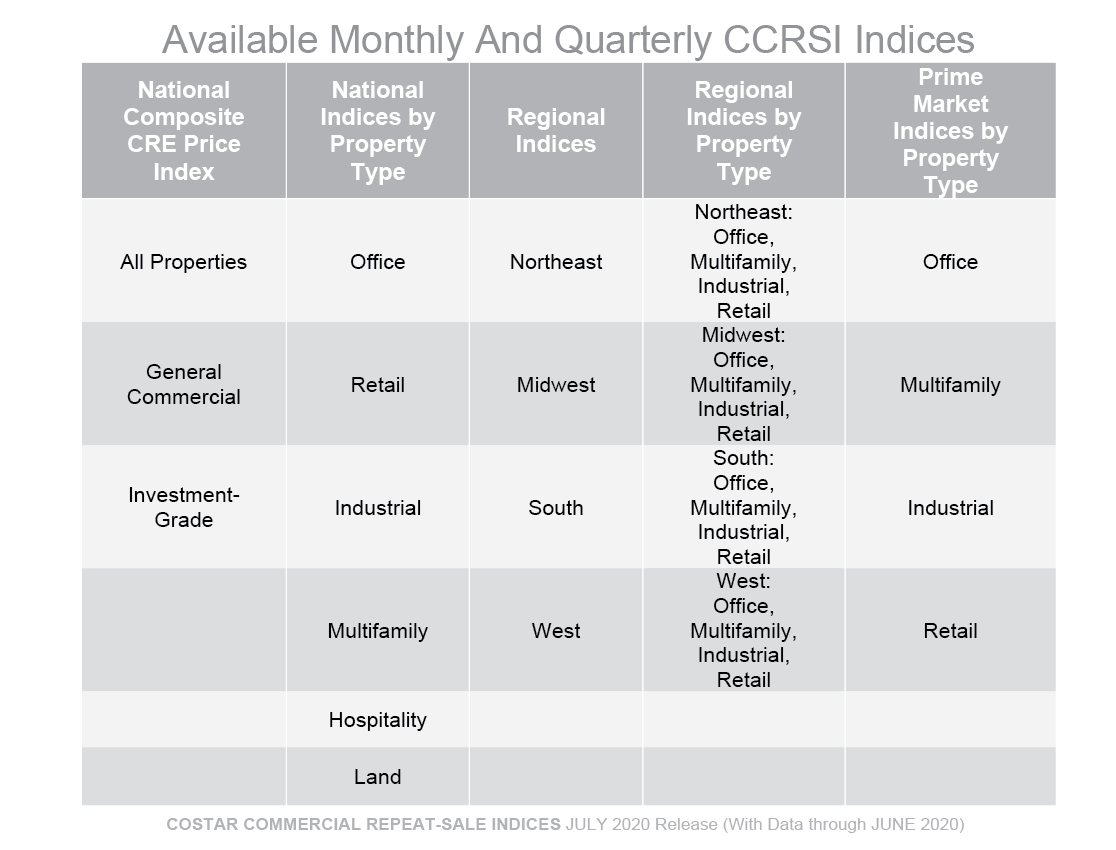
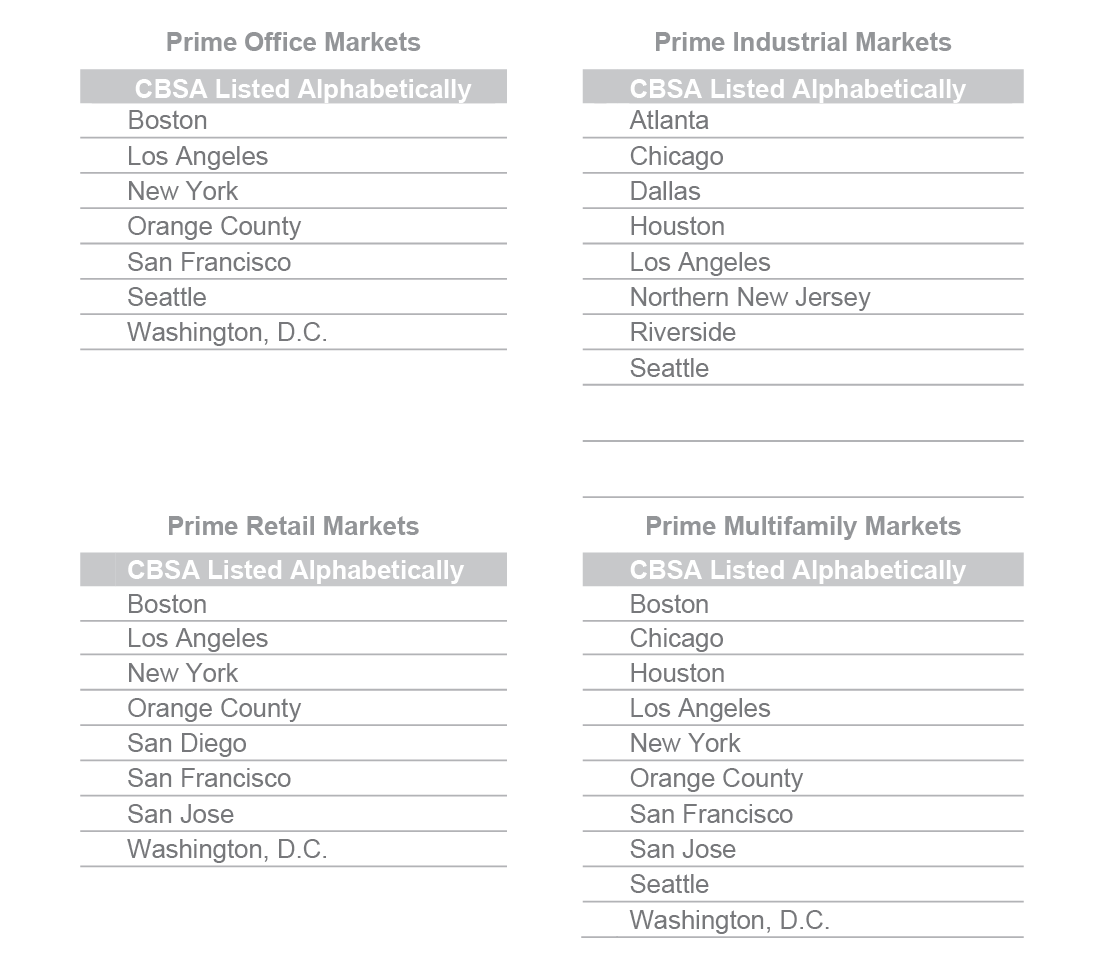
Media Contact:
Gay Beach, Senior Director, Marketing Communications, CoStar Group (gbeach@costargroup.com).
For more information about the CCRSI Indices, including the full accompanying data set and research methodology, legal notices and disclaimer, please visit https://costargroup.com/costar-news/ccrsi.
ABOUT COSTAR GROUP, INC.
CoStar Group, Inc. (NASDAQ: CSGP) is the leading provider of commercial real estate information, analytics and online marketplaces. Founded in 1987, CoStar conducts expansive, ongoing research to produce and maintain the largest and most comprehensive database of commercial real estate information. Our suite of online services enables clients to analyze, interpret and gain unmatched insight on commercial property values, market conditions and current availabilities. STR provides premium data benchmarking, analytics and marketplace insights for the global hospitality sector. Ten-X provides a leading platform for conducting commercial real estate online auctions and negotiated bids. LoopNet is the most heavily trafficked commercial real estate marketplace online with over 7 million monthly unique visitors. Realla is the UK’s most comprehensive commercial property digital marketplace. Apartments.com, ApartmentFinder.com, ForRent.com, ApartmentHomeLiving.com, Westside Rentals, AFTER55.com, CorporateHousing.com, ForRentUniversity.com and Apartamentos.com form the premier online apartment resource for renters seeking great apartment homes and provide property managers and owners a proven platform for marketing their properties. CoStar Group’s websites attracted an average of approximately 62 million unique monthly visitors in aggregate in the second quarter of 2020. Headquartered in Washington, DC, CoStar maintains offices throughout the U.S. and in Europe, Canada and Asia with a staff of over 4,200 worldwide, including the industry’s largest professional research organization. For more information, visit www.costargroup.com.

